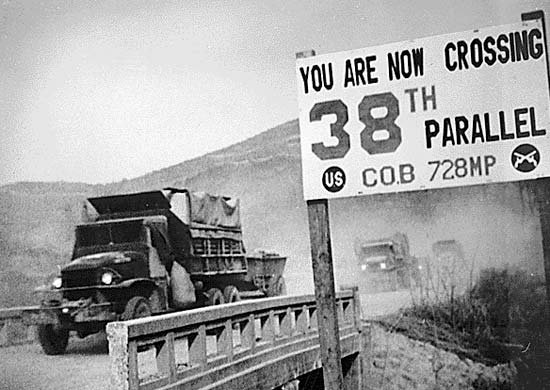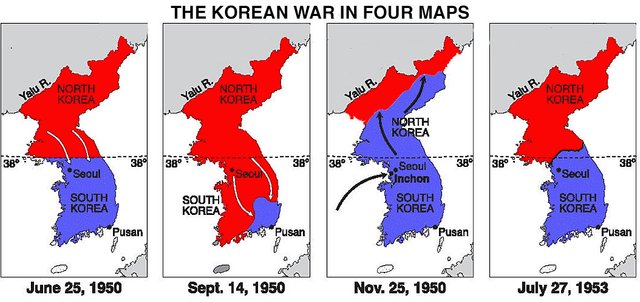KOREAN WAR (1950-1953) - History of USA #12
- BACKGROUND
Korea was one nation that was divided at the end of World War II to allow for occupation by various countries of the victorious coalition of the Allies (Britain, the Soviet Union, the United States, France, China, Canada and Australia). Korea had been under Japanese control for many years but after World War II it was occupied by Russian and US forces. The country was divided into North and South Korea, with the thirty-eight parallel of latitude as the boundary line.
- DIFFERENCES BETWEEN NORTH & SOUTH KOREA
In North Korea, the Soviets organized a communist regime called the Democratic People's Republic of Korea. Kim II-sung (1912-1994) was its first premier. South Korea was led by Syngman Rhee (1875-1965) and became known as the Republic of Korea (ROK). Both governments wanted to unify Korea, but each wanted to do so on its own terms. The North would invade the South, and then the South would retaliate, keeping the country in a constant state of conflict. Even so, US troops pulled out in June 1949. Only a small group of advisers stayed behind. South Korea's army was small and poorly trained, whereas North Korea had an army of 135,000 men equipped with the most modern Russian weapons. It also boasted between 150 and 200 combat planes. South Koreans and some Americans worried that North Korea might attack across the thirty-eighth parallel at any time. On January 12, 1950, US Secretary of State Dean Acheson announced that Korea was not part of the defensive parameter of the United States vital interests in Asia, implying that the United States might not fight over Korea. This declaration was interpreted by some as an invitation to the communists to invade South Korea.

The 38th Parallel (border between North & South Korea)
- BEGINNING OF WAR & ACTION BY UNITED NATIONS
Whether or not it was an invitation, the North Korean Army crossed the thirty-eighth parallel to attack South Korea on June 25, 1950. Because North Korea invaded without warning, it met with little resistance and within 36 hours the army was moving its tanks into the outer suburbs of Seoul, the capital of South Korea. The UN Security Council unanimously passed a resolution calling for an immediate end to the hostilities and withdrawal of North Korean forces back to their original position behind the thirty-eighth parallel. North Korea ignored the order, so the UN Security Council met again on June 27 and recommended that members of the UN assist South Korea in repelling the attack. President Harry S. Truman committed US air and naval forces to struggle in addition to the ground forces already stationed in Japan. But this was not enough to keep the communists from advancing. By the end of the month, more than half of the ROK army had been destroyed, and the US forces were forced to fight as they retreated south. Fifteen other nations sent in troops. On September 15, 1950 General Douglas MacArthur, commander in chief of the Far East and Supreme commander of the UN forces, launched a surprise attack not from the port of Pusan but from the landing at Inchon, the west-coast port just outside of Seoul. North Korean forces were expecting a land attack, not an assault from water . MacArthur's strategy forced the communists back across the thirty-eighth parallel.

Korean War in four maps
- STALEMATE BETWEEN FORCES OF BOTH SIDES
The UN coalition had to decide whether to pursue the communist forces across the thirty-eighth parallel or not. The US wanted a complete victory. So, Truman gave MacArthur permission to cross the boundary. MacArthur had already decided that this would be his plan, and the first crossings took place on Oct 1. By late November, UN and ROK troops had forced the enemy to the river boundary between North Korea and communist China. China came to aid the North Korea, making good on its warning that it would not allow North Korea to be invaded. Thousands of Chinese soldiers sided with their Communist brothers, and UN troops began to withdraw. By July 1951, a stalemate was reached. The fighting settled into trench warfare, with each side digging in. The bloody battles continued for two years, with more than one million Americans serving in Korea.
- NEGOTATIONS
While troops were fighting, negotiations were initiated by the communists. The talks were repeatedly called off because the communists were using them to spread propaganda and to make the fighting last as long as possible. Meanwhile the US was getting frustrated with the deadlock on the battlefield. In 1953, President Truman left office and was replaced by Dwight D. Eisenhower, a Republican who won support by promising to go to Korea, if elected. He kept his promise, but the trip had little, if any, influence on the peace talks.
An agreement was finally reached and signed on July 27, 1953. It called for ceasefire and the withdrawal of both the armies about a mile from the existing battle line, which was just below the thirty-eighth parallel. The treaty also called for the creation of Neutral Nations Supervisory Commission to enforce the terms of the truce. A conference would be held to settle all the questions, including the future of Korea and the fate of prisoners of war who refused to return home. In the following months, the UN repatriated more than 70,000 North Korean and communist prisoners. In return they received only 3,597 Americans, 7,848 South Koreans, and 1,315 prisoners of other nationalities. The conference was never held and the tensions remained high between North and South Korea.
- CONCLUSION
The Korean War lasted just over three years and cost the United States 140,000 casualties (dead and wounded) and $22 billion. It prevented Communism from spreading into South Korea and proved that the United States would fight to contain communism. With the Korean War, US policy shifted from war for total victory to limited war with no demand for total victory.
I think most if not all major wars in the last century have all been to enforce the current political agenda :)
Awesome blog! Keep up the good work
Congratulations! This post has been upvoted from the communal account, @minnowsupport, by Junaid from the Minnow Support Project. It's a witness project run by aggroed, ausbitbank, teamsteem, theprophet0, someguy123, neoxian, followbtcnews/crimsonclad, and netuoso. The goal is to help Steemit grow by supporting Minnows and creating a social network. Please find us in the Peace, Abundance, and Liberty Network (PALnet) Discord Channel. It's a completely public and open space to all members of the Steemit community who voluntarily choose to be there.